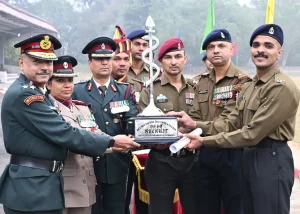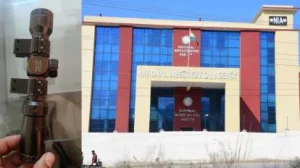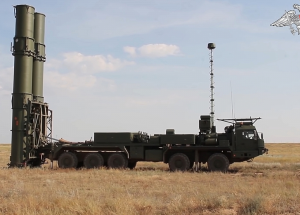Raksha Mantri Reaches Srinagar
- Raksha Mantri Sri Rajnath Singh reviewed the situation at the Borders and also visited the forward areas in Jammu & Kashmir.
- He had a brief interaction with the ITBP officials and personnel posted in forward areas of Ladakh.
- He even chaired a security review meeting.
- He also visited the holy cave of Amarnath and took blessings there.
Point Blank exercise ups the ante on collective defense
- Exercise Point Blank is a recurring large force Exercise designed and co-hosted by the Royal Air Force and the 48th Fighter Wing of USAFE. It is a low-cost initiative created to increase tactical proficiency of Department of Defense and Ministry of Defence forces stationed within the United Kingdom and Europe.
- The 48th Fighter Wing Public Affairs has announced on Friday that Royal Netherland Air Force F-16s and F-35As partnered with 4th and 5th generation aircraft from the Royal Air Force and F-15s from the 48th Fighter Wing during exercise Point Blank, for the first time.
- More than 60 aircraft took off from home stations and met in the skies over the North Sea for a realistic, high-fidelity training environment that included KC-135 Strato-tankers and a RC-135 Rivet Joint from RAF Mildenhall, along with NATO Airborne Warning and Control Systems.
- The exercise fully integrates fifth-generation technology and capabilities, and leads the development and execution of live, virtual, and constructive training to support full-spectrum readiness.
- “Exercise Point Blank provides UK Combat Air the opportunity to operate alongside our USAFE colleagues in demanding, large scale air wars,” said RAF Air Vice Marshal Marshall, Air Officer Commanding 1 Group. “During this iteration of the exercise we were joined by F-16s and F-35s from the Dutch Air Force as well as a NATO E-3A; thus testing our ability to plan and co-ordinate across a number of dispersed units in multiple countries.”
- Multi-lateral exercises like Point Blank increase interoperability and collective readiness, deter potential adversaries and ensure the skies within the European theater remain sovereign.
- “These exercises are valuable for ensuring our Airmen sharpen their combat readiness and increase tactical proficiency,” said Col. Jason Camilletti, 48th Fighter Wing commander. “We will continue to safeguard U.S. national interests and those of our allies and partners throughout this COVID-19 crisis, and these types of exercises ensure we can meet that priority.”
150,000 troops, 414 aircraft: Putin puts troops on alert
- Russian president Vladimir Putin has ordered an urgent drill to test the combat readiness of the armed forces, according to Russian Defense Minister Sergei Shoigu.
- Shoigu said they would involve about 150,000 military personnel, more than 26 thousand military vehicles, 414 aircraft, 106 ships and vessels. The exercises will involve 35 training grounds and training fields, as well as 17 marine training grounds in the Black and Caspian Seas.
- The drill involves army, navy and air force troops based in the western military district, a vast territory bordering Ukraine, Belarus, the Baltic states, Finland, and the Arctic.
- The Russian defense minister issued instructions to implement the programs of troops’ combat training and cohesion during the drills and qualification exercises.
- “The results of training measures held should be taken into account in assessing the level of the preparedness of military large units and formations for taking part in the Kavkaz-2020 [Caucasus-2020] strategic exercise [scheduled for September],” the defense chief said.
- Also, the missile formation of the 58th Combined Arms Army of the Southern Military District, stationed in North Ossetia, has begun to march to one of the training grounds in the Stavropol Territory to conduct a tactical exercise.
- More than 500 servicemen of the Southern Military District are taking part in the planned combat training event, about 100 pieces of equipment are involved, including the Iskander-M operational-tactical missile system.
- At the training ground in the Stavropol Territory, servicemen of the Southern Military District will practice electronic missile launches from the Iskander-M missile system at the enemy at a distance of up to 500 km.
- The operational-tactical missile system is designed to destroy enemy multiple launch rocket systems, anti-missile, and air defense systems, aircraft and helicopters at airfields, command posts, and infrastructure facilities. The complex includes two types of missiles: ballistic and cruise.
- At the same time, Ukraine is fearing that Russia will use massive military exercises to invade. Deputy Minister for Foreign Affairs of Ukraine Vasyl Bodnar said that Ukraine needs to be mentally prepared for the fact that Russia will not stop using its armed forces for political and economic objectives.
- “A significant number of military experts and analysts share the opinion about the possibility of a military offensive. NATO also understands how real it is to use Russia’s military potential against Ukraine, and its activation is possible in the near future. Therefore, we need to be mentally prepared for the fact that Russia will not stop using its armed forces for political and economic objectives,” he said in an interview with Interfax-Ukraine.
Dynetics to develop tactical space support vehicles
- Dynetics has announced that its wholly owned subsidiary Leidos has concluded testing the US Army Space and Missile Defense Command’s (USASMDC) Lonestar tactical space support payloads.
- Through the Design, Development, Demonstration, and Integration (D3I), Domain 1 task order, Dynetics will develop, test, integrate and demonstrate two tactical space support vehicles (TSSV) that will be used to enhance all phases of joint force operations.
- Dynetics completed the payload design in only four months. This progress was the result of the company’s expertise in high-performance signal processing applications for defense, intelligence and spaceflight hardware development. The payload hardware and flight software were completed, integrated and verified within 18 months. This took place at Dynetics’ small satellite development labs, where hardware-in-the-loop (HWIL) simulations were conducted to exercise the system following a “Test Like You Fly” approach.
- “With our strengths in critical payload technologies, space hardware and software development, secure labs and manufacturing capabilities, Dynetics is taking on the challenge to meet emerging national space defense goals.” said Mike Graves, Dynetics space systems department manager and Lonestar program manager.
U.S. Army takes new steps to create killer robots
- In a recent report, the Combat Capabilities Development Command noted that military researchers are working to integrate the next generation of technology-enabled capabilities to demonstrate new robotic capabilities to meet emerging military needs.
- The Next Generation Combat Vehicle – Cross Functional Team and CCDC Ground Vehicle Systems Center, in collaboration, are conducting soldier operational experiments to assess the feasibility of integrating unmanned vehicles into ground combat formations at Fort Carson, Colorado, from June 15 – Aug. 14, 2020.
- The MET-D leverages the latest technology in sensors, data display, graphical user interface, drive-by-wire capability, unmanned aerial vehicle-provided video, and advanced communications to support Soldiers. Robotic Combat Vehicles, operated from the manned combat vehicle, are unmanned platforms which can contact the enemy before the Soldiers do, while achieving overmatch–decisive mobility, survivability, and lethality–against future operating environment threats.
- Operating within this MET-D concept, the demonstration is structured around three main events: Operator Training, Gunnery, and Situational Training Exercises (STX).
- While robotic technology is a novel approach to solving ground vehicle problems for the Army and Soldiers, this latest demonstration marks the early stages of a multi-year process where the Army will determine the best way to integrate new technologies and autonomous vehicles into the way it fights.
U.S. Navy commissions new amphibious assault ship Tripoli
- The U.S. Navy on Wednesday commissioned its newest amphibious assault ship, named for the Battle of Derne in 1805. The name honors and commemorates the force of U.S. Marines and approximately 370 soldiers from 11 other nationalities who captured the city of Derna, Libya, during the 1805 Battle of Derna. The battle resulted in a subsequent peace treaty and the successful conclusion of the combined operations of the First Barbary War, and was later memorialized in the Marines’ Hymn with the line, “to the shores of Tripoli.”
- Although the Navy canceled the traditional public commissioning ceremony due to public health and safety restrictions on large public gatherings, the Navy commissioned the USS Tripoli administratively and the ship transitioned to normal operations. Meanwhile, the Navy is looking at a future opportunity to commemorate the special event with the USS Tripoli’s sponsor, crew, and commissioning committee.
- Tripoli’s commanding officer, Capt. Kevin Myers, highlighted Tripoli’s accomplishments over the past several months getting through initial sea trials. The hard work and dedication of the entire team during the past few years was evident in the successful execution of at-sea testing.
- “Being the third ship to bear the Tripoli namesake is a profound honour and this crew stands ready to carry on the legacy of our longstanding Navy and Marine Corps amphibious community,” said Meyers. “These sailors and Marines will pave the way for those still to come. What is remarkable is seeing the dedication, perseverance and resilience these new plank owners have shown since day one, and more recently, through uncertain times as the Navy and nation work through a pandemic. There is no doubt in my mind that this team is ready to answer the nation’s call at any time or place.”
Bell releases incredible video of its prototype rotorcraft
- Bell Textron Inc., part of American conglomerate Textron, has released new video footage shows the Bell 360 Invictus prototype submission as part of the U.S. Army’s Future Attack Reconnaissance Aircraft (FARA) program.
- Posted on the company’s Youtube channel, the computer-generated animation showed a prototype rotorcraft designed to provide improved lethality, survivability, and extended reach for Army Aviation.
- The FARA competition seeks to test and acquire a next-generation attack reconnaissance aircraft to fill a critical capability gap identified by the Army on a rapid schedule.
- The Army requires an aircraft capable of operating in a complex airspace and degraded environments against peer and near-peer adversaries with an advanced integrated air defense system. The current aviation fleet does not possess a dedicated aircraft to conduct armed reconnaissance, light attack, and security with improved standoff and lethal and non-lethal capabilities from a platform sized to hide in radar clutter and for the urban canyons of mega cities.
- The Army has long needed a new reconnaissance aircraft. Back in 2012, the Army reassigned a portion of its AH-64 Apache fleet to support heavy attack reconnaissance squadrons, as a replacement for the OH-58 Kiowa. After FARA is fielded, the Army plans to replace about 50 percent of its aging AH-64 fleet.
- Operating within Future Attack and Reconnaissance Aircraft concept, the U.S. Army selected two performers executing under Other Transaction Authority for Prototype agreements for the design and testing of the Competitive Prototypes to continue into phase two of the program.
- The two vendors selected are Bell Helicopter Textron Inc. (Fort Worth, Texas) and Sikorsky Aircraft Corp. (Stratford, Connecticut).
- As part of the selection, Bell is designing, manufacturing, and testing the Bell 360 Invictus, a prototype rotorcraft designed to provide improved lethality, survivability, and extended reach for Army Aviation.
- “The selection of the Bell 360 Invictus to continue in the FARA program builds on our decades-long legacy as an innovator in reconnaissance rotorcraft supporting the maneuver force,” said Mitch Snyder, president and CEO of Bell. “Our team has applied innovative thinking with tested technology to give the Army a low-risk option to fulfill its requirements on an aggressive schedule.”
- According to the company, the Bell 360 addresses the requirements with a design optimized to achieve the performance, connectivity, sustainability, and reliability for soldiers to fight and operate in multi-domain operations. The aircraft is expected to meet or exceed the Army’s requirements, using proven Bell technologies such as fly-by-wire flight controls, a proven articulated rotor design, and an innovative blade design to name a few.
- The Future Attack Reconnaissance Aircraft is the Army’s number one aviation modernization priority and is integral to effectively penetrate and dis-integrate adversaries’ Integrated Air Defense Systems.
REVIEW QUESTIONS
- Exercise Point Blank is a recurring large force Exercise designed and co-hosted by the Royal Air Force and the:
- 46th Fighter Wing of USAFE
- 47th Fighter Wing of USAFE
- 48th Fighter Wing of USAFE
- 49th Fighter Wing of USAFE
ANSWER: C
- The urgent drill that is ordered by Vladimir Putin involves Russian army, navy and air force troops based in the western military district, a vast territory bordering:
- Ukraine
- Belarus
- Finland
- All of the Above
ANSWER: D
- Dynetics’ small satellite development labs, where hardware-in-the-loop (HWIL) simulations were conducted to exercise the system, followed what approach?
- “Fly Like You Test” approach
- “Test Like You Fly” approach
- “Dive Like You Test” approach
- “Test Like You Dive” approach
ANSWER: B
- Bell releases incredible video of its prototype rotorcraft named:
- Bell 360 Invictus
- Bell 360 Invincible
- Bell 360 Incredible
- Bell 360 Instantous
ANSWER: A
- Bell 360 Invictus comes under US Army’s FARA program. FARA means:
- Forward Attack Reconnaissance Aircraft
- Forward Attack Retrograde Aircraft
- Future Attack Reconnaissance Aircraft
- Future Attack Retrograde Aircraft
ANSWER: C



















